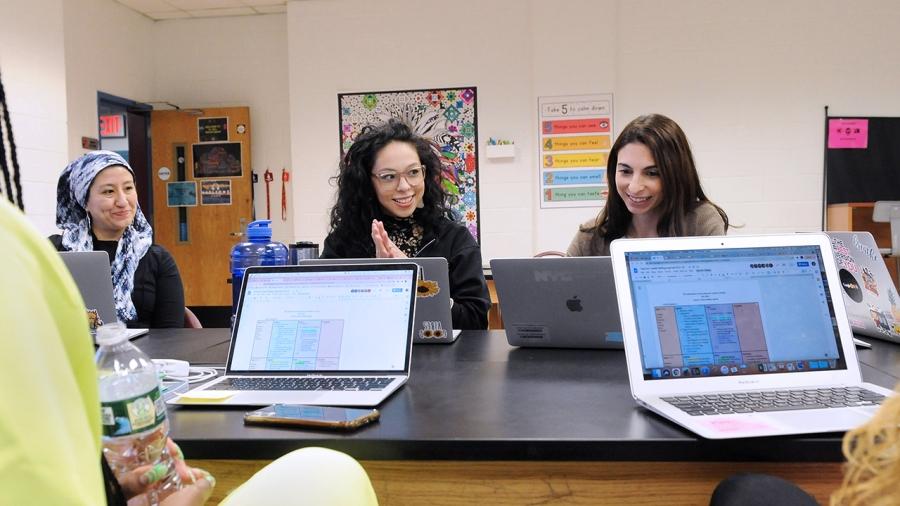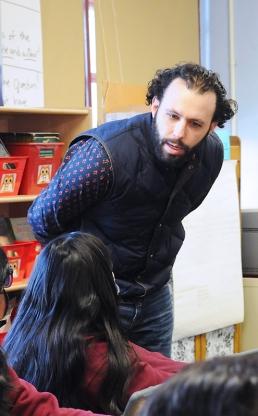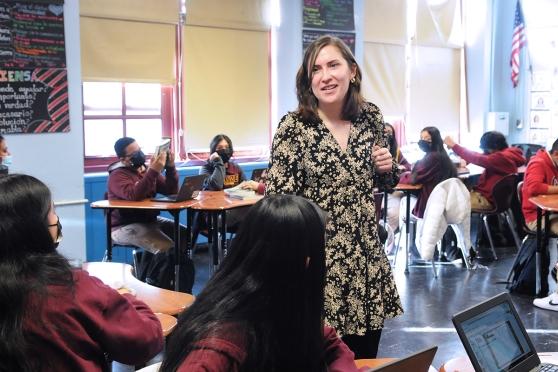Dream team

Members of the teacher leader team, including (from left) special education liaison Carla Carballo, master teacher Samantha Chung and peer collaborative teacher Lindsay Roscus, meet weekly to debrief from recent professional learning sessions and plan next steps.
On a chilly March morning in the basement of IS 145 in Jackson Heights, Queens, a team of eight teacher leaders was grappling with the challenge of how to discuss iReady assessment data with teachers and students.
“When my students look at the data and see themselves so far below grade level, they’re devastated,” said Carla Carballo, the school’s special education liaison.

Sixth-grade teacher Nathan Einschlag focuses on giving kids room to speak.
“Maybe — I’m just brainstorming here — we use the Habits of Mind as a way into the conversation about data,” replied ELA teacher Samantha Chung, a master teacher, referring to an identified set of 16 problem-solving, life-related skills. “The first Habit of Mind is persistence. We can ask students, ‘Where does the data show you persisting?’”
As they talked, restorative justice teacher Taniqua Scott took notes on a shared Google document, while special education teacher Lindsay Roscus, a peer collaborative teacher, interjected to keep the group focused on its objective for the PD session.
Formed in 2014 by a principal who believed in distributive leadership, the teacher leader team has stepped up to help IS 145 keep pace with the changing needs of the students and the teachers at this school, which is located in one of the city’s most ethnically diverse neighborhoods.
“When I started teaching, it was like survival of the fittest,” said the school’s UFT Teacher Center coordinator Sophia Tsimaris, who has been at IS 145 since she was a student teacher 23 years ago. “Now it’s a totally different dynamic, with so many resources for growth. It’s been an empowering learning process for all of us.”
An important part of their work is supporting new teachers. Nearly 10% of IS 145’s 120 educators are brand new this year.
“We have a whole new era of teachers who have never seen pre-pandemic teaching — things like how to facilitate a gallery walk or collaboration and social norms in group work in the classroom are all new to them,” said Chung.
Each of the teacher leaders acts as a mentor to a new teacher, providing one-on-one coaching, opportunities to reflect on their teaching practice and a listening ear.
“When I came here, I was like a lost fish in the ocean. Samantha gave me that moral support,” said Tajkia Ahmed, a first-year teacher who teaches a standalone English as a New Language class and worked with Chung to build a curriculum from scratch.
The teacher leader team has worked to build connections between veteran teachers, too. An intervisitation calendar encourages teachers to sign up to visit one another’s classrooms. A book club for the school’s educators, led by Chung, is reading Gholdy Muhammad’s “Cultivating Genius: An Equity Framework for Culturally and Historically Responsive Literacy.”

The team works to support new teachers like Erin Quinn, who says it’s been “incredibly helpful” to have the teacher leaders as a resource.
Another cornerstone of their work as teacher leaders is facilitating professional learning for the school’s staff. The teacher leaders meet weekly as a group to debrief after each professional learning session, share feedback from fellow educators and discuss next steps.
A major focus this year has been the implementation of social-emotional practices throughout the curriculum.
“This year we’ve focused on holding space for the kids’ emotions and giving them room to talk,” said 6th-grade teacher Nathan Einschlag.
In the fall, the team worked with staff members to develop SMART (specific, measurable, attainable, relevant and time-based) goals and plans of action. In one recent professional learning workshop, participants discussed the practice of setting intentions for the day in their classes.
When the teacher leaders visited one another’s classrooms the next day, Einschlag displayed the intention-setting activity on his whiteboard.
Because the school is so large, teachers and students are divided into four “academies” — one of which, the Global Academy, entirely serves students who are newcomers to the country. Among the teacher leaders are representatives from each academy, the different grades and various subject areas to ensure that “all voices are heard,” said Jayme Klapman, a technology teacher and a peer collaborative teacher.
In a recent debriefing session, the teacher leaders discussed a recurring theme in their colleagues’ feedback: their desire for immediate, practical strategies to implement in their classrooms.
“I have split feelings about that, because on the one hand, teachers 100% need those ideas and we do give them. But on the other hand, we have to protect space for teachers to plan themselves,” said Chung.
“It’s not just about a bag of tools, it’s a mindset,” Scott agreed.